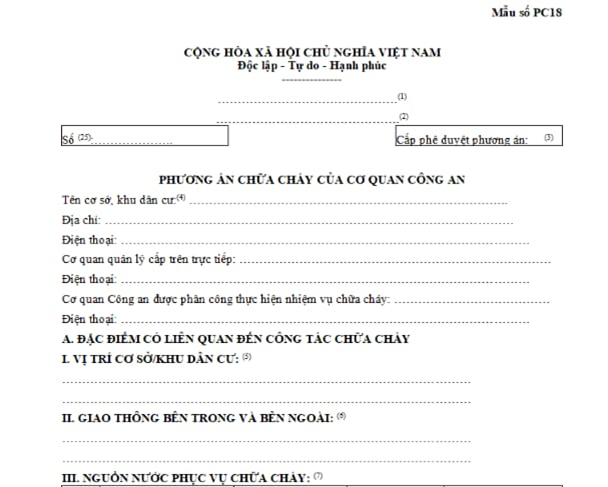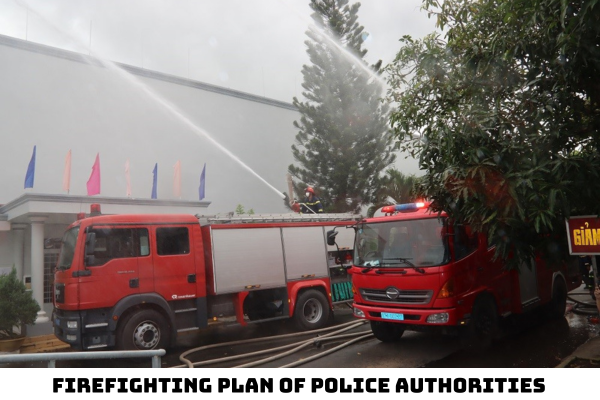Vietnam: What is the latest firefighting plan form of police authorities? What are the instructions for correctly recording the firefighting plan of police authorities?
What is the latest firefighting plan form of police authorities in Vietnam?
The latest firefighting plan form of police authorities in Vietnam is Form No. PC 18 issued together with Decree 136/2020/ND-CP as follows:

Download the latest firefighting plan form of police authorities in Vietnam: Here.

What are the instructions for correctly recording the firefighting plan of police authorities in Vietnam?
Pursuant to Form No. PC 18 promulgated together with Decree 136/2020/ND-CP, the instructions for correctly recording the firefighting plan of police authorities in Vietnam are:
(1) Name the superior governing body of the agency developing the firefighting plan.
(2) Name the agency that developed the firefighting plan.
(3) Issuance of firefighting plan approval, stating:
- "C07" for the firefighting plan approved by the Director of the Police Department of Fire Prevention, Fire and Rescue and Rescue;
- "UBT" for fire extinguishing plans approved by the Chairman of the provincial People's Committee;
- "UBT + C07" for the firefighting plan approved by the Chairman of the People's Committee of the province and the Director of the Police Department of Fire Prevention, Fire Fighting and Rescue and Rescue;
- “CAT” for the firefighting plan approved by the Director of the Provincial Public Security;
- “PC07” for the firefighting plan approved by the Chief of the Police Department of Fire Prevention and Fighting and Rescue and Rescue of the Provincial Police;
- "UBH" for firefighting plan approved by district-level People's Committee chairpersons;
- “CAH” approved by the district-level police chief.
(4) Enter the name of the establishment/residency according to the administrative transaction document.
(5) Location of facilities/residential areas: Specify facilities, works, streets, rivers and lakes adjacent to the four directions of East, West, South and North.
(6) Internal and external traffic: Specify the routes and distances from the police authority assigned to perform the fire fighting task to the residential area; routes inside and outside the facility accessible to motorized fire fighting vehicles.
(7) Water source for fire fighting: Statistics of water sources around the establishment that can serve fire fighting such as: tanks, lakes, ponds, rivers, streams, canals, canals, piers, water intake wharves, intake pits water..., specifying the ability to get water in seasons and times of the day; indicating location, distance to water sources outside.
(8) Properties and characteristics of the danger of fire, explosion, and toxicity:
- Outline the architectural and construction characteristics of the work items (number of floors, fire-resistant levels, ground area, types of materials of major construction components such as walls, columns, ceilings, floors, etc.) roof...).
- Number of people regularly present in work items; operation and utility properties of the work items related to fire, explosion and toxic hazards.
- Fire and explosion hazard characteristics of major combustible substances (type of combustible material, location, arrangement, quantity, volume, fire velocity, fire characteristics, toxic factors when burning, possibility of fire) fire spread to the surrounding area).
- Types of heat sources capable of causing fire (bare fire, electrical system failures, electrical equipment, technical problems...).
(9) Organization of the on-site fire fighting force: State the organizational situation, the number of fire prevention and fighting crew members, and the number of people who have been trained in fire prevention and fighting. The number of people standing during and outside working hours.
(10) On-site fire-fighting means: Statistics on types, quantity and location of motorized fire-fighting means, wall fire-fighting systems, life-saving means..., equipment, and tools capable of being used for fire fighting).
(11) Assume the most complex fire situation:
- Assume the fire situation is large-scale, complicated, can cause serious damage to people and property, fire fighting is the most difficult, it is necessary to mobilize many new forces and means. manageable, with specific assumptions about when the fire occurred (maybe at night or outside of working hours, late detection and alarm);
- The starting point of the fire, the cause of the fire and the cause of the big fire; main type of combustible substance, free burning time; scale and area of the fire at the time of fire detection.
- Anticipate the development of the fire and the factors affecting the fire fighting such as high temperature, smoke, toxic gas, and collapse of the building...
- Estimated location and number of victims in the fire area.
(12) Fire fighting techniques: Based on the size, area, type, nature and characteristics of the fire, the main combustible substances, the type of fire development (assumption) and the ability to mobilize Mobilize forces and means to devise appropriate tactics, techniques, methods, and measures of fire fighting
(13) Calculation of fire fighting force and means:
- On the basis of applying firefighting tactics and techniques to the hypothetical fire situation, calculate the number of forces, means and fire-fighting substances necessary for firefighting (organizing reconnaissance, rescuing people, guiding escape.
- Cooling, demolishing to prevent fire spread; supplying water for fire fighting, saving property...) and serving fire fighting (ladder trucks, ambulances, water trucks, excavators, bulldozers, cranes, forklifts...).
- In case the calculation of necessary forces and means for firefighting exceeds the response capacity of their units or localities, the mobilization of firefighting forces and means of units and agencies must be taken into account. organizations inside and outside the locality to request competent people to mobilize.
(14) Force and means to be mobilized: Based on the calculation results in (13) to record in the statistical table of forces and means to be mobilized (including those of internal and external units). security or other locality's fire fighting aid).
(15) Tasks of the local force:
- Write a summary of the firefighting tasks that will be assigned to the commander and the on-site firefighting force, in which, they must coordinate with the grassroots force to know information about the status of the power source in the fire area.
- Type and quantity of combustible substances in the fire, especially for chemicals that are dangerous in terms of fire, explosion, and toxicity; potentially explosive areas.
- Exploit and use on-site firefighting water sources and ensure logistics for fire fighting in case of long-term fire fighting.
- Organize the protection of the scene to serve the investigation of the cause of the fire and remedy the consequences of the fine
(16) Tasks of the Fire Prevention and Fighting Police Force:
- Clearly state the tasks and roles of the fire commander in receiving and processing information about the fire, and organizing the mobilization and mobilization of forces and means to fight the fire.
- In case the fire is determined to be large-scale, complicated and prolonged, the fire-fighting commander must promptly propose the establishment of a fire-fighting steering committee to mobilize forces and means of agencies and organizations, households, and individuals inside and outside the locality to provide firefighting aid according to their competence.
- Set up a commanding committee, a firefighting advisory board, and determine the number and specific tasks of members of the committees. When arriving at the scene, they must organize fire fighting according to regulations (organize fire reconnaissance, grasp the situation of victims, scale and evolution of the fire, exploit and use fire fighting water sources.
- Determine the firefighting area and assign specific tasks to the units participating in the firefighting.
- Propose and organize the implementation of combat measures, firefighting techniques and rescue according to each stage in accordance with the current situation of firefighting forces and means.
- Timely inform and coordinate with other participating forces to ensure order, traffic, health care, water supply, communication, lighting, and logistics to ensure fire fighting). In the case of long-term firefighting, there must be a plan to replace troops, supplement fuel, fire-fighting substances and food, and at the same time organize to encourage the fighting spirit of officers and soldiers participating in firefighting.
In addition to organizing firefighting, the fire commander must actively gather information about the fire for reporting and communication purposes.
When the fire has been completely extinguished, the fire-fighting commander must organize the recovery of fire-fighting forces and means, gather information and statistics to serve the preparation of reports; coordinate in protecting the scene, serving the investigation of the cause of the fire.
(17) Tasks of other forces: Specify the basic tasks that will be assigned to the mobilized forces to participate in firefighting and perform other activities related to firefighting.
(18) Diagram of the force of fire fighting means:
- Draw the overall plan of the facility, which shows the adjacent works, roads, rivers, and lakes...
- Main wind direction.
- Transporting water sources inside and directing water sources outside the facility; the location of the fire; the size of the fire area; the direction of the development of the fire; command board position; main attack direction; arrange forces and means of fire fighting of the participating units... by uniform symbols as prescribed in this model of the plan.
In case of organizing fire fighting in many stages, it can be presented by many diagrams for convenience when exploiting and using for fire command. The diagram uses A4 or larger paper size accordingly.
(19) Plans to deal with some typical fire situations: For establishments having areas, items, and buildings with similar operational and functional properties (such as classrooms, buildings, etc.) LPG storage tanks, and working rooms...) select a typical area, item, or work as a fire simulation to develop a treatment plan.
Situations are arranged in the order of "Case 1, 2, 3...", the content of each situation is summarized similarly to that of the most complex fire situation.
(20) Supplement and adjust the firefighting plan: If the supplemented or adjusted contents in the plan are related to the firefighting organization of the facility.
(21) Monitor learning and practicing the firefighting plan: After each training and practice of the firefighting plan, basic information about the time of learning and practicing that plan must be recorded.
(22) Powers and positions of the person approving the firefighting plan. For the plan with the mobilization of forces and means of local agencies, organizations, the army, and the police force of provincial police in neighboring localities, the handling will be handled by the Chairman of the Committee. Provincial people approve directly in the section "Approval of the plan", the Director of the Fire Prevention and Rescue Police Department will have written approval of the separate plan.
(23) Powers and positions of the unit commander who organizes the development and submission of firefighting plans (Teams, Divisions, District-level Police Departments, Provincial-level Public Security Forces).
(24) Powers and positions of the person directly developing the firefighting plan or presiding over the formulation of the firefighting plan;
(25) The number of the firefighting plan shall be recorded by the police authority according to the number of the application for approval of the firefighting plan (according to the regulations of the Ministry of Public Security on the work of dossiers and statistics on police operations).
When detecting a fire, which agency is it required to report to?
Pursuant to Clause 1, Article 20 of Decree 136/2020/ND-CP as follows:
Responsibility for fire incident reporting, fire fighting and firefighting participation
1. Anyone detecting a fire must inform people around them about it and notify one or all of the following units:
a) The neighborhood watch or internal/specialized firefighting force of the locality where the fire occurs;
b) The nearest police authority or firefighting authority;
c) The government of the locality where the fire occurs.
...
Thus, according to the above regulations, when detecting a fire, it is required to report to one or all of the following units:
- The neighborhood watch or internal/specialized firefighting force of the locality where the fire occurs;
- The nearest police authority or firefighting authority;
- The government of the locality where the fire occurs.
LawNet